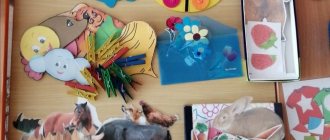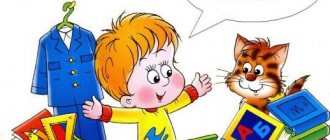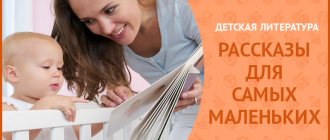PROJECT “SPEECH THERAPY GAMES”
I. _ stage
- prephonemic
II . stage
– phonemic
Prephonemic stage
At the 3rd week, the newborn begins to react to the voice.
By 4 months, reaction to the voice and intonation of spoken speech.
By 5 months, the child grasps the general rhythmic, melodic structure of the word.
At 9-10 months - a reaction to the intonation and meaning of some words. From this time on, the self-learning mechanism begins to work.
From the age of 11 months, the child distinguishes contrasting sounding words ba-ba, pa-pa, ma-ma.
From 11-12 months, phonemic hearing begins to develop. At this time, phonemic hearing allows:
understand the speech of others;
imitate others;
establish a connection between words and objects.
Phonemic stage
By the age of 2, the child differentiates all speech sounds only by ear, and understands well the speech of an adult addressed to him.
By the age of 5-6 years, children already differentiate all sounds both by ear and in pronunciation.
Research by N.H. Shvachkin is confirmed by literary sources and other authors (M.I. Lisina, E.O. Smirnova, V.V. Vetrova, etc.)
In parallel with phonemic hearing, which carries out the operations of discrimination and recognition of phonemes, phonetic hearing also develops, which carries out “monitoring of a continuous stream of syllables.” Phonemic and phonetic hearing together make up speech hearing,
which carries out not only the reception and assessment of other people's speech, but also control over one's own speech. Speech hearing is the most important stimulus for the formation of normalized pronunciation, which can only be carried out with coordinated work between the mechanisms of auditory control and reception on the one hand and control of speech movements on the other.
The functional unity of speech perception and speech production is mentioned in the works of N.I. Zhinkin, N.Kh. Shvachkina, V.I. Beltyukova, A.A. Leontyeva and others.
Even during the birth of phonological theory, the largest linguist Baudouin de Courtenay pointed out that the structure of a phoneme is determined by both acoustic and motor components.
Investigating the patterns of development of children's speech, A.N. Gvozdev notes that the general course of a child’s assimilation of the sound side of speech is determined by the joint action of the auditory and motor spheres: “The auditory sphere is leading in the sense that thanks to the early development of hearing, the child learns to distinguish various phonetic elements by ear; their exact auditory representations become a regulator for their development in his own pronunciation. But for their appearance in the child’s own speech, in addition to auditory ideas, articulatory skills are also needed... These skills are developed later, and with their development, sound elements freely enter into the child’s own speech. From this side, the development of the motor sphere turns out to be decisive for the entire course of mastering the phonetic aspect of the native language. A.N. Gvozdev “A child’s acquisition of the sound side of the Russian language,” Moscow 1948)
Pedagogical project in the senior speech therapy group “Living sounds and letters”
Pedagogical project in the senior speech therapy group of a kindergarten
Author of the work: Svetlana Mikhailovna Radulova, teacher-speech therapist, Municipal Educational Institution “Bendery Kindergarten No. 9”, Bendery. Description: the project was developed for a senior speech therapy group. This material will be useful to speech therapists and educators in teaching preschoolers the elements of literacy. Type of project: creative, group, long-term. Duration of the project: September-May Project participants: children of the senior group of OHP, speech therapist, educator, parents. Problem: children with general speech underdevelopment have insufficiently formed prerequisites for mastering literacy. Goal: teaching elements of literacy to older preschoolers with special needs through the use of game techniques and visual and didactic material. Objectives: Develop phonemic awareness. Strengthen children's knowledge of sounds and letters. Improve the skills of sound-syllable analysis and synthesis. Improve the skill of reading syllables, words, sentences with completed letters. Develop mental processes in children: perception, memory, thinking. To increase the effectiveness of the correctional work of a speech therapist to prepare children for school through cooperation with parents. Relevance of the project: There is a direct relationship between the level of a child’s speech development and his ability to master literacy. Data from A.N. Korneva (1995), M.Z. Kudryavtseva (1995), G.A. Glinna (1996), T.A. Tkachenko (2000) show that, on average, older preschoolers with general speech underdevelopment are almost twice as ready to learn to read and write than normally speaking children. Children with OSD have not developed the initial skills of sound and syllabic analysis of words, which is especially important when teaching children to read and write, as it serves to prevent written language disorders when studying at school. Therefore, one of the most important tasks of remedial education for preschoolers with severe speech impairments is literacy training. It is not easy for a child to understand what a sound, syllable, word, sentence is if the teacher’s explanations are not supported by illustrative material. To successfully teach children to read and write, it is necessary to use a variety of means that allow them to perceive information visually. Support for project activities: methodological (planning, lesson notes, literature), material and technical (computer, teaching aids, games, visual material) Forms of work: conversations, reading and discussion, game exercises, questions and answers, memorization, storytelling. Expected result: - Increased children's interest in learning to read and write. — Expansion, activation of vocabulary, development of grammatical structure and coherent speech in children. — Development of phonemic perception, consolidation of the skills of correct sound pronunciation and sound-letter analysis. — Developing skills in composing and reading syllables, words, sentences. — Increasing the communicative and creative abilities of children. — Strengthening cooperation between preschool teachers and families in preparing children for school. Product of the project activity: Production of a visual didactic aid “The Kingdom of Sounds and Letters” Creation of a collection of poems about letters and sounds.
Creation of a collection of fairy tales about sounds and letters, compiled by children together with their parents. Project implementation stages:
Stage 1. Preparatory - Determining the goals and objectives of project activities. — Informing teachers and parents about the project. — Distribution of functional responsibilities between project participants. — Drawing up an activity plan. — Primary examination of children. — Drawing up a long-term calendar plan for teaching literacy. — Creation of a literacy center. — Production of a visual didactic aid “The Kingdom of Sounds and Letters.” — Production of didactic games, diagrams, cards. — Studying methodological literature on teaching literacy. Stage 2. Main - Reading to children the fairy tale “The Kingdom of Sounds and Letters” - Conducting subgroup and frontal literacy classes using the visual didactic aid “The Kingdom of Sounds and Letters”. — Conducting didactic games for teaching literacy. — Compiling fairy tales for children together with their parents about the sounds and letters they are learning. — Intermediate diagnostics of children. — A selection of poems about sounds and letters. - Making letters from various materials by children in the classroom and at home. — Consultation for teachers on teaching children literacy. — Seminar-workshop for parents “Teaching literacy to children of senior preschool age with special needs development.” — Consultation for parents “Preparation for teaching literacy to children with special needs” stage 3. Final - Organizing an exhibition of letters made by children together with their parents.
— Presentation of a collection of fairy tales about sounds and letters. — Final literacy lesson “In the Kingdom of Sounds and Letters” for parents. Implementation of the project
Lesson structure using visual teaching aids
Introduction to vowel sounds Equipment: manual “The Kingdom of Sounds and Letters” (Vlasiki, letters), typesetting canvas, traffic light cards, reading cards, container with letter details, counting sticks, strings, container with colored pencils. 1. Description of the palace in the kingdom of sounds in which Glasik lives. 2. Game exercise “Glasik does exercises.” (Improving articulatory motor skills). 3. Game exercise “Glasik’s favorite song” (singing a vowel sound). 4. Portrait of Glasik (characteristics of sound). 5. Game "Hide and Seek". (Development of phonemic perception. Isolation of an isolated sound in a series of sounds, syllables). 6. Games “Let's treat Glasik”, “Give a gift” (Improving sound analysis skills). 7. Game “Glasik’s Walk” (determining the place of sound in words). 8. Games “Let’s make friends with the Glasiks”, “The Glasiks quarreled” (Improving the skills of sound analysis and synthesis). 9. Introducing the letter. A poem, a fairy tale about a letter. 10. Game exercise “Describe a portrait of a letter” (naming the elements of a letter) 11. Laying out a letter from a letter constructor, sticks, laces, working with a template. 12. Game “Let’s make letters together.” (Improving reading skills). 13. Finger gymnastics. (Coordination of speech with movement. Development of fine motor skills). 14. Printing letters in notebooks. (Development of fine motor skills). 15. Coloring pictures. (Development of fine motor skills, visual perception. Prevention of written speech disorders). Introduction to consonant sounds Equipment: manual “The Kingdom of Sounds and Letters” (sounds, letters), a typesetting canvas, traffic light cards, cards with words for reading, a container with letter details, counting sticks, strings, a container with colored pencils, object pictures, chips for sound analysis. 1. Description of the palace in the kingdom of sounds in which Soglasik lives. 2. Game exercise “The conspirator does exercises.” (Improving articulatory motor skills). 3. Portrait of Soglasik (characteristics of sound). 4. Game "Hide and Seek". (Development of phonemic perception. Isolation of an isolated sound in a series of sounds, syllables, words). 5. Games “Let's treat Solasik”, “Give a gift” (Improving sound analysis skills). 6. Game “Walk of Consent” (determining the place of sound in words). 7. Games “Let’s make friends with the sound guys”, “Sound guys quarreled” (Improving the skills of sound analysis and synthesis). 8 *. Meeting Soglasik's younger brother. 9. Introducing the letter. A poem, a fairy tale about a letter. 10. Game exercise “Describe the portrait of the letter” (naming the elements of the letter). 11. Laying out letters from a letter constructor, sticks, strings, working with a template. 12. Game “Let’s make letters together.” (Improving reading skills). 13. Finger gymnastics. (Coordination of speech with movement. Development of fine motor skills). 14. Printing letters in notebooks. (Development of fine motor skills). 15. Coloring pictures. (Development of fine motor skills, visual perception. Prevention of written speech disorders). Differentiation of sounds and letters Equipment: manual “The Kingdom of Sounds and Letters” (Consonants, letters), a typesetting canvas, multi-colored flags, cards with words for reading, a container with colored pencils, subject pictures and chips for syllabic analysis 1. Description of the palace in the kingdom of sounds , in which the Soglasiks live. 2. Game exercise “The conspirator does exercises.” (Improving articulatory motor skills). 3. Speech exercises. (Differentiation of sounds in syllables, words) 4. Portraits of sound units (characteristics of sounds). 5. Games “Stamp - clap”, “Multi-colored flags” (differentiation of sounds in a series of sounds, syllables, words) 6. Games “Let's treat Solasikov”, “Give gifts”. (Improving sound analysis skills). 7. Finger gymnastics. (Coordination of speech with movement. Development of fine motor skills). 8. Game "Find the letters." 9. Game “Give gifts to letters” (Improving sound-letter analysis skills). 10. Exercise “Read and distinguish.” (Prevention of written speech disorders.) Fairy tale “The Kingdom of Sounds and Letters” Once upon a time, there lived two princesses in the same kingdom of sounds. In the red palace there lived a princess who loved to listen to her servants sing in a loud voice. The princess's name was Glasa, and her servants were Glasiki. Each Glasik had his own name. Six Glasiks sang vowel sounds. Glasa always wore a red dress, and Glasiki always wore red shirts.
In another palace lived a princess whose servants knew how to angrily hiss, growl, ring, and whistle. The princess's name was Soglasa, and her servants were called Soglasiki. Soglasa had a beautiful blue-green dress. The older brothers pronounced hard consonants and wore blue shirts. The younger brothers knew how to softly ring, whistle, growl and utter soft consonant sounds. They wore green clothes. Those who spoke loudly wore bells. These are sonorous consonants. The deaf Concorders did not have bells.
All Glasiks and Soglasiks lived cheerfully, amicably and never quarreled.
They loved to walk together, holding hands. Games with sound students
“Let's make friends with sound students” Purpose: Development of skills in sound analysis and synthesis. Equipment: image of sound players. The speech therapist shows and pronounces first [a], and then [t]. Children name which syllable they got. “The sound guys quarreled” Goal: Development of phonemic awareness. Equipment: image of sound players. The speech therapist shows and pronounces the syllable ga
.
Children name the first and second sounds. “Let's help the hedgehog” Goal: improving sound analysis skills. Equipment: images of consent, hedgehog, basket, apples with pictures. Children help the hedgehog find apples with the sound [zh] and treat the hedgehog. The speech therapist names the picture depicted on the apple and offers to determine the presence of the sound [zh] in the word.
“Funny Bus” Goal: improving sound analysis skills. Equipment: images of consent, bus, subject pictures. Soglasik [s] is going to travel by bus with friends. Children find passengers by sound [s].
“Funny Truck” Goal: improving sound analysis skills. Equipment: images of consent, truck, subject pictures. Soglasik [z] is riding in a truck with friends. Children find passengers by sound [z]. “Give gifts to those who agree” Purpose: differentiation of sounds in words. Equipment: images of consent, subject pictures. Children name pictures, determine the presence of the sound [s] or [z], and give gifts to those who agree.
Children name pictures, determine the presence of the sound [s] or [s], and give gifts to those who agree.
“Give a sound student a word” Goal: Development of phonemic perception. Equipment: image of a sound player. Children name words that have a certain sound. “Fun Train” Goal: improving the skill of syllabic analysis of words. Equipment: images of consent, trains with carriages, subject pictures. Soglasik [in] is going on a trip with friends. Those passengers whose names have one syllable will travel in the first carriage, two syllables in the second carriage, and three syllables in the third carriage. Children seat passengers.
Games with letters
“Give gifts to letters” Goal: improving sound-letter analysis skills. Equipment: images of letters, subject pictures. Children give gifts to the letters G and K. The letter G is given pictures whose names begin with the letter G. The letter K is given pictures whose names begin with the letter K. “Hide and Seek” Purpose: Development of visual attention and perception. Prevention of writing disorders. Equipment: images of letters. The letters are hidden in the cabinet so that only small fragments of them are visible. Children are asked to name the letters.
“Make letters friends” Goal: Improving reading skills. Equipment: images of letters. The child names the first letter and reads the syllable together.
Letters made by children together with their parents
Summary of a lesson on teaching literacy using a visual didactic aid /blogs/svetlana-mihailovna-radulova/konspekt-zanjatija-po-obucheniyu-gramote-v-starshei-logopedicheskoi-grupe.html Summary of the final lesson “In the kingdom of sounds and letters” / blogs/svetlana-mihailovna-radulova/konspekt-logopedicheskogo-zanjatija-po-obucheniyu-gramote-v-korolevstve-zvukov-i-bukv.html Conclusion: The “Living Sounds and Letters” project made it possible to realize the set tasks and goals. As a result of project activities, children's interest in classes on teaching elements of literacy increased. Children have developed the skills of sound-letter analysis, reading words and sentences. The children's vocabulary expanded, the skills of correct sound pronunciation were strengthened, and the communicative function of speech increased. Parents of children have become active participants in the educational process. References used: 1. Aleksandrova T.V. Live sounds, or Phonetics for preschoolers. - St. Petersburg; “Childhood-Press”, 2005 2. Bykova I. A. Teaching children to read and write in a playful way: Methodological manual. – St. Petersburg: “CHILDHOOD-PRESS”, 2005. 3. Kravchenko I.V. Games and exercises with sounds and words. - M.: Publishing house "Gnom-Press", 1998 4. Nishcheva N.V. Notes of subgroup speech therapy classes in the senior group of kindergarten for children with special needs. - SPb.: CHILDREN'S PRESS 2007. 5. Nishcheva N. Playing and reading . - SPb., CHILDREN'S PRESS, 2003. 6. Novotortseva N.V. Learning to read: teaching literacy in kindergarten and at home. – Yaroslavl, 1998. 7. Smolyanaya V.S. Card index of games for teaching literacy and reading. – Mozyr: Assistance, 2010 8. Filicheva T., Chirkina G. Elimination of general speech underdevelopment in preschool children. - M., 2004.
We recommend watching:
Project in kindergarten “These different balls” Information and research project in the preparatory group Information and research project on traffic rules in the preparatory group Pedagogical project in the senior speech therapy group of the preschool educational institution
Similar articles:
Creative project in the senior group on the topic “The Mysterious World of Insects”
Pedagogical project in the second junior group of kindergarten
Features of a teacher’s use of the project method in a preschool educational institution
Educational – creative project in the preparatory group “Soon to school”
Pedagogical project in the middle group “Know and follow the road rules!”




